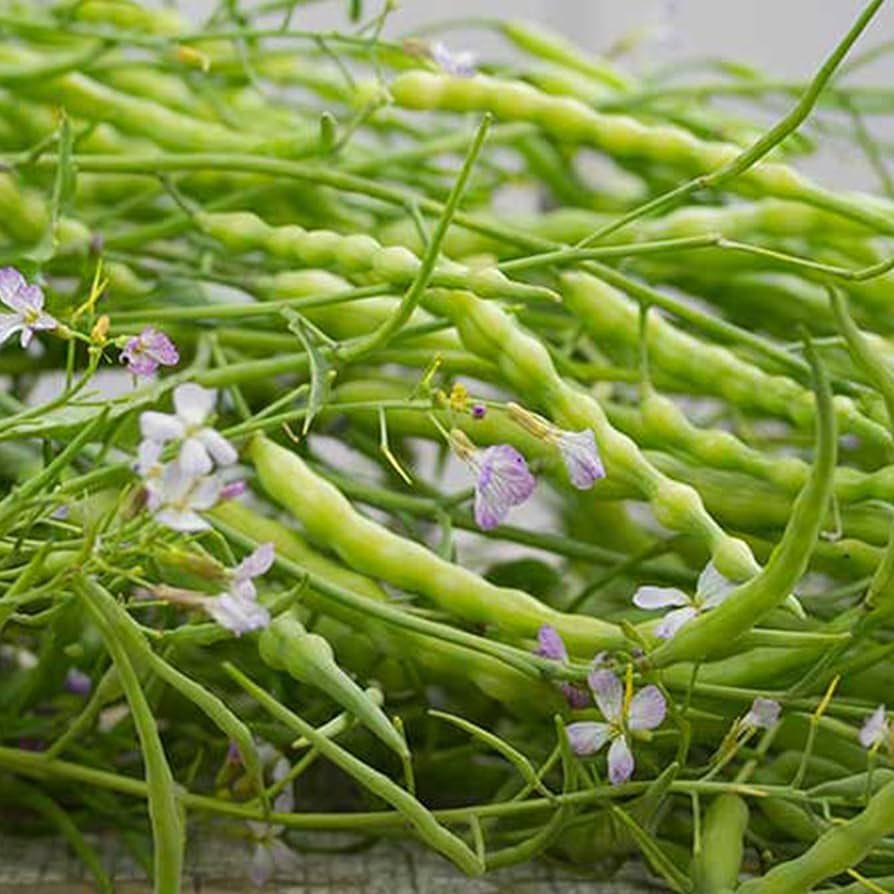Rattail Radish
Quantity: 100 seeds+
Rat tail radish (Raphanus sativus var. caudatus) is an unusual and fascinating variety of radish grown not for its roots but for its edible seed pods. This variety is also known as “pods radish” or “serpent radish.” It has a long history of cultivation in Southeast Asia and has gained popularity among gardeners and food enthusiasts for its unique appearance and culinary uses.
Rat tail radish (Raphanus sativus var. caudatus) is an unusual and fascinating variety of radish grown not for its roots but for its edible seed pods. This variety is also known as “pods radish” or “serpent radish.” It has a long history of cultivation in Southeast Asia and has gained popularity among gardeners and food enthusiasts for its unique appearance and culinary uses.
Key Characteristics
Appearance: Rat tail radish plants produce long, thin seed pods that can range from 15 cm to over 30 cm in length. The pods are typically green, sometimes tinged with purple. Flavor: The seed pods have a crisp texture and a spicy, peppery flavor similar to that of traditional radish roots but often milder. They can be eaten raw or cooked.
Growth Habit: The plant is a fast-growing annual, reaching up to 1-2 meters in height, with small white to pink flowers that develop into the distinctive seed pods.
Cultivation in India
Climate: Rat tail radish thrives in warm, tropical climates, making it well-suited for cultivation in many parts of India. It prefers a temperature range of 15°C to 30°C.
Soil: Prefers well-drained, fertile soil with good organic matter content. The ideal soil pH is between 6.0 and 7.0.
Regions: It can be grown in various regions across India, particularly in areas with mild winters and warm summers.
Growing Practices Sowing: Seeds are directly sown into the field or garden bed at a depth of 1-2 cm. Rows should be spaced about 45-60 cm apart, with 30-45 cm between plants within a row.
Thinning: Seedlings are thinned to ensure proper spacing and good air circulation.
Watering: Regular watering is essential to maintain soil moisture, especially during the flowering and pod development stages. However, overwatering should be avoided to prevent root rot.
Weeding and Fertilization: Regular weeding helps reduce competition for nutrients. Applying well-rotted compost or farmyard manure before sowing enhances soil fertility. Balanced fertilizers can be used based on soil test recommendations.
Harvesting
Time to Harvest: Rat tail radish pods are typically ready for harvest about 50-60 days after sowing.
Method: Harvest the pods when they are young and tender, usually when they reach about 15-20 cm in length. Older pods can become tough and fibrous.
Culinary Uses Raw Consumption: The seed pods can be eaten raw, often added to salads for a crunchy, spicy element.
Pickling: Commonly pickled with vinegar and spices, serving as a tangy and spicy condiment.
Stir-fries and Curries: Used in various cooked dishes, such as stir-fries and curries, where they add a unique texture and flavor.
Garnishes: The pods can be used as garnishes for various dishes, adding visual appeal and a hint of spice. Nutritional Benefits Vitamins: Rich in vitamin C and other antioxidants.
Minerals: Contains potassium, calcium, and magnesium.
Fiber: High in dietary fiber, aiding digestion.
Low Calorie: Low in calories, making them a healthy addition to the diet. Health Benefits Digestive Health: High fiber content promotes healthy digestion and bowel regularity.
Immune Support: Vitamin C and antioxidants support the immune system.
Hydration: High water content helps keep the body hydrated. Detoxification: Believed to aid in detoxifying the body and improving liver function. Summary Rat tail radish is a unique and versatile vegetable grown primarily for its edible seed pods. With a mild, peppery flavor and crisp texture, these pods can be enjoyed raw, pickled, or cooked in various dishes. Well-suited for warm climates, rat tail radish is easy to cultivate and offers numerous nutritional and health benefits. Its distinctive appearance and culinary versatility make it a fascinating addition to gardens and kitchens alike.
| Weight | 12 g |
|---|







Reviews
There are no reviews yet.